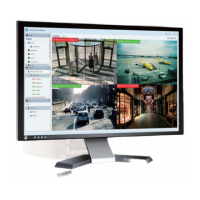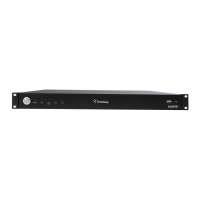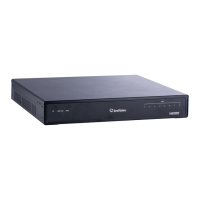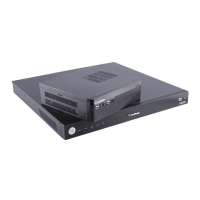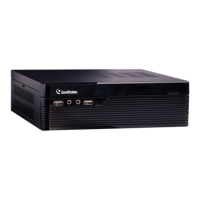Do you have a question about the GeoVision GV-VS21600 and is the answer not in the manual?
Overview of GV-Video Server models and their key features.
Lists all items included in the GV-Video Server package for each model.
Details compatible software and necessary system requirements for the GV-Video Server.
Explains Power over Ethernet support for specific GV-Video Server models.
Describes the GV-Video Server's GPS tracking capabilities and supported models.
Details optional accessories that expand the GV-Video Server's capabilities.
Identifies and describes the physical components on the front and rear of the GV-Video Server.
Provides basic steps for connecting the GV-Video Server to a network.
Guides users on how to find the GV-Video Server's IP address using the utility.
Explains how to assign a static IP address or configure network settings.
Points to key basic configurations for the GV-Video Server after installation.
Steps to access surveillance images via a web browser after installation.
Introduces features available on the GV-Video Server's main page, like Live View.
Covers video settings, motion detection, privacy mask, and tampering alarms.
Details connections and configurations for digital I/O, PTZ cameras, GPS, and Wiegand.
Explains how to set up e-mail, FTP, Center V2, Vital Sign Monitor, and GV-GIS alerts.
Describes how to start and stop recording and I/O monitoring manually or by schedule.
Covers setting up schedules for recording and I/O monitoring.
Explains how to use the Remote ViewLog function to play back recorded files.
Details LAN, wireless, TCP/IP, UMTS, Multicast, and IP Filter settings.
Covers date/time settings, storage management, user accounts, logs, and tools.
Steps to enable and configure video/audio recording directly to storage.
Describes methods for playing back recorded video files using USB or network.
Instructions for updating the GV-Video Server firmware via web or utility.
How to back up and restore GV-Video Server configurations using the IP Device Utility.
Details on tracking vehicle location using GPS and Google Maps.
Procedures for resetting the GV-Video Server to its factory default settings.
Explains how to verify the integrity of recorded video using watermarking.
Guide to integrating GV-Video Server cameras into GV-DVR/NVR systems.
Instructions for setting up GV-Video Server cameras with the GV-VMS software.
How GV-DVR/NVR receives cardholder data from the GV-Video Server via Wiegand.
Using Multi View for monitoring cameras and I/O devices connected to the GV-Video Server.
Creating and using E-Maps for monitoring cameras and I/O devices.
Configuration for connecting and monitoring GV-Video Servers with Center V2.
Setting up Vital Sign Monitor to manage GV-Video Servers under low bandwidth.
Configuring the Dispatch Server to distribute GV-Video Server subscribers to busy Center V2 servers.
Details pin assignments for the terminal blocks on various GV-Video Server models.
Describes the terminal block pin assignments for the GV-VS11 model.
Explains the pin assignments for the I/O cable and RS-232 terminal block on GV-VS12.
Configuration steps for Internet Explorer 8 and later to ensure proper functionality.
Lists compatible wireless LAN USB adapters for GV-Video Servers.
Lists supported mobile broadband devices for GV-Video Servers.
Provides RTSP commands for audio and video streaming with the GV-Video Server.
Lists PTZ camera models and protocols supported by the GV-Video Server.
Explains how to use CGI commands for snapshots and accessing the user account interface.
A table listing default port values for various network services used by the GV-Video Server.
Overview of GV-Video Server models and their key features.
Lists all items included in the GV-Video Server package for each model.
Details compatible software and necessary system requirements for the GV-Video Server.
Explains Power over Ethernet support for specific GV-Video Server models.
Describes the GV-Video Server's GPS tracking capabilities and supported models.
Details optional accessories that expand the GV-Video Server's capabilities.
Identifies and describes the physical components on the front and rear of the GV-Video Server.
Provides basic steps for connecting the GV-Video Server to a network.
Guides users on how to find the GV-Video Server's IP address using the utility.
Explains how to assign a static IP address or configure network settings.
Points to key basic configurations for the GV-Video Server after installation.
Steps to access surveillance images via a web browser after installation.
Introduces features available on the GV-Video Server's main page, like Live View.
Covers video settings, motion detection, privacy mask, and tampering alarms.
Details connections and configurations for digital I/O, PTZ cameras, GPS, and Wiegand.
Explains how to set up e-mail, FTP, Center V2, Vital Sign Monitor, and GV-GIS alerts.
Describes how to start and stop recording and I/O monitoring manually or by schedule.
Covers setting up schedules for recording and I/O monitoring.
Explains how to use the Remote ViewLog function to play back recorded files.
Details LAN, wireless, TCP/IP, UMTS, Multicast, and IP Filter settings.
Covers date/time settings, storage management, user accounts, logs, and tools.
Steps to enable and configure video/audio recording directly to storage.
Describes methods for playing back recorded video files using USB or network.
Instructions for updating the GV-Video Server firmware via web or utility.
How to back up and restore GV-Video Server configurations using the IP Device Utility.
Details on tracking vehicle location using GPS and Google Maps.
Procedures for resetting the GV-Video Server to its factory default settings.
Explains how to verify the integrity of recorded video using watermarking.
Guide to integrating GV-Video Server cameras into GV-DVR/NVR systems.
Instructions for setting up GV-Video Server cameras with the GV-VMS software.
How GV-DVR/NVR receives cardholder data from the GV-Video Server via Wiegand.
Using Multi View for monitoring cameras and I/O devices connected to the GV-Video Server.
Creating and using E-Maps for monitoring cameras and I/O devices.
Configuration for connecting and monitoring GV-Video Servers with Center V2.
Setting up Vital Sign Monitor to manage GV-Video Servers under low bandwidth.
Configuring the Dispatch Server to distribute GV-Video Server subscribers to busy Center V2 servers.
Details pin assignments for the terminal blocks on various GV-Video Server models.
Describes the terminal block pin assignments for the GV-VS11 model.
Explains the pin assignments for the I/O cable and RS-232 terminal block on GV-VS12.
Configuration steps for Internet Explorer 8 and later to ensure proper functionality.
Lists compatible wireless LAN USB adapters for GV-Video Servers.
Lists supported mobile broadband devices for GV-Video Servers.
Provides RTSP commands for audio and video streaming with the GV-Video Server.
Lists PTZ camera models and protocols supported by the GV-Video Server.
Explains how to use CGI commands for snapshots and accessing the user account interface.
A table listing default port values for various network services used by the GV-Video Server.
| Brand | GeoVision |
|---|---|
| Model | GV-VS21600 |
| Category | Recording Equipment |
| Language | English |

